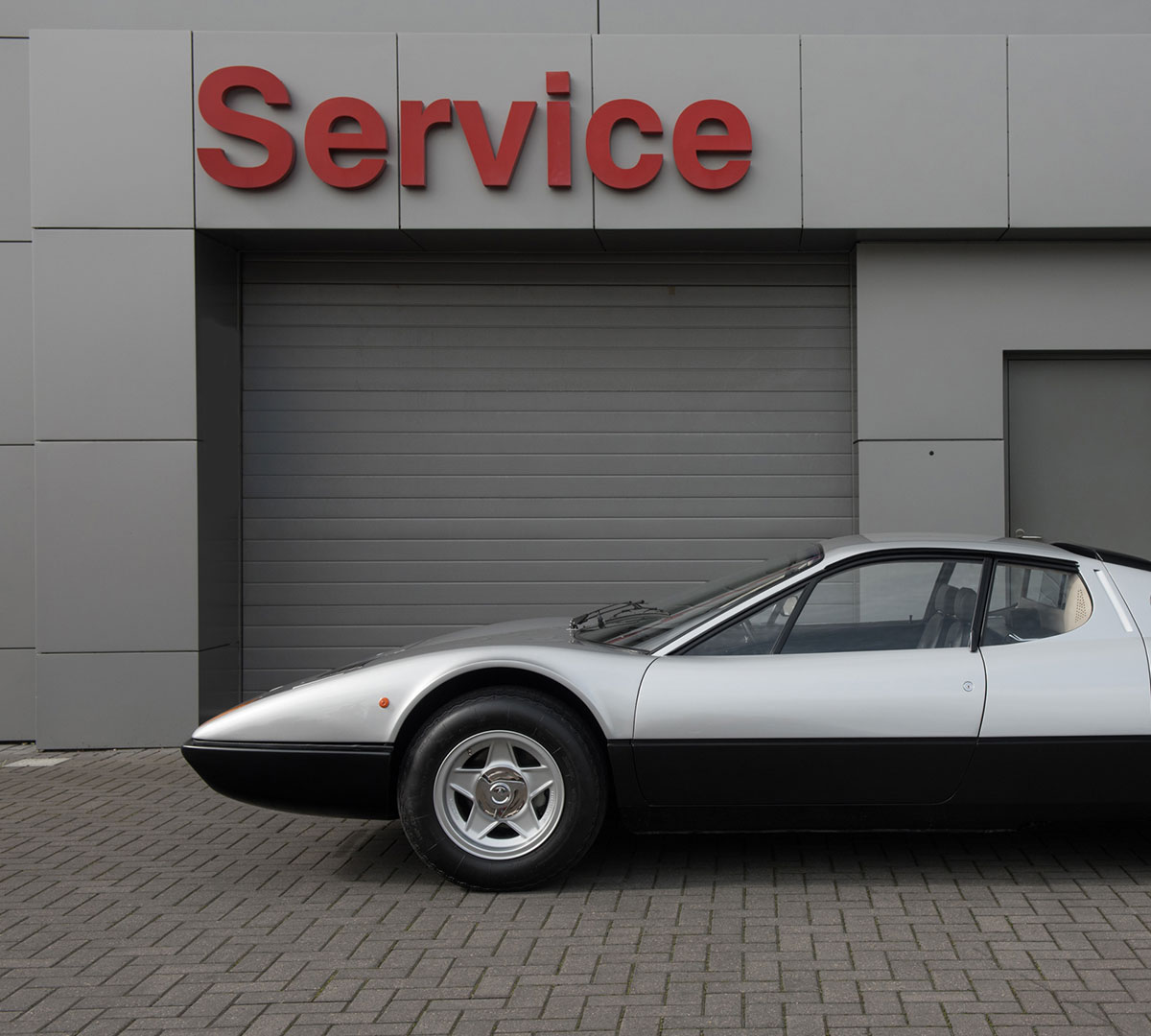?width=768&height=1024)
Ferrari 512 BBi
Bosch K-Jetronic mechanical fuel injection on the 512 BBi replaced the outgoing model’s four, triple-choke Weber 40 IF 3C carburettors. Otherwise mechanically identical, the flat-12 featured lower maximum revs (6,600 rpm compared to the 512 BB’s 6,800 rpm) and the engine developed 20 bhp less, although top speed remained within a whisker of the 512 BB’s 283 km/h.

Design
Externally the new model was recognisable by the re-designed rear bumper and wheels, the side NACA duct finished in black and the body-colour wing mirror. Inside, the classic Connolly leather seats featured a central wool textile insert and the car was fitted with air conditioning and central locking as standard.

The 512 BBi was introduced at the 1981 Frankfurt Salon, to replace the 512 BB model, the “i” suffix denoting a change from carburettors to fuel injection. Apart from the adoption of fuel injection, in line with the other models in the Ferrari range at the time, there were minor cosmetic and mechanical changes.
At the front the plain aluminium egg-crate radiator grille stopped short of the driving lights, which were now exposed in the grille extremities, with small rectangular parking lights mounted in the bumper section above them. At the rear the engine louvre arrangement was modified and a new shroud was provided to the exhaust system, which incorporated hazard warning lights. A new design of door mirror was fitted, changes were made to the interior, including a black spoked steering wheel, and the availability of “Zegna” wool cloth seat centres as an option.

The road wheels became the same width front and rear, fitted with Michelin TRX tyres, which had the effect of increasing the front and rear track to 1508mm and 1572mm respectively.
The body was mounted on a 2500mm wheelbase chassis, which had factory reference number F 102 CB 100. All were numbered in the odd chassis number road car sequence, and the construction followed the same principles as its predecessor of a tubular steel chassis frame with a monocoque central cell. Again as with its predecessor it was available in right or left hand drive form, and again no USA market versions were built.


The engine
The standard road wheels were alloy five spoke “star” pattern, with a knock off spinner on a Rudge hub, although legislative requirements in some markets dictated the fitment of a large octagonal hub nut. The wheels covered large ventilated disc brakes with twin hydraulic circuits, and servo assistance. Independent suspension was provided all round, via wishbones, coil springs, and hydraulic shock absorbers, with twin rear units, together with front and rear anti roll bars.

The aluminium flat twelve cylinder engine was of the same configuration as its predecessor with a cubic capacity of 4943cc, and 82mm x 78mm bore and stroke, with factory type reference F 110 A 000. It featured belt driven twin overhead camshafts per bank, with dry sump lubrication and a hydraulically operated clutch. The 512 BBi was fitted with Bosch K-Jetronic fuel injection, and had the same claimed power output as the carburettor model.
The production period ran from 1981 to 1984, when it was replaced by the world market Testarossa model. During that period a total of 1007 examples were produced, in the chassis number range 38121 to 52935.

- V12engine
- 4943.04 ccTotal displacement
- 340 CVMaximum power
- 280 km/hTop speed
- 类型纵向后置Flat-12
- 缸径/冲程82 x 78mm
- 单缸排量411.92cc
- 总排量4943.04cc
- 压缩比9.2 : 1
- 最大功率在6000 rpm的转速下为250 kW (340 hp)
- 升功率69hp/l
- 最大扭矩-
- 气门驱动每侧缸组双顶置凸轮轴,每缸两气门
- 燃油供给博世 K-Jetronic喷射
- 点火电子喷射,每缸单火花塞
- 润滑干式油底壳
- 离合器双片
- 车架钢管
- 前悬挂独立不等长叉臂,螺旋弹簧,伸缩式减震器,防倾杆
- 后悬挂独立不等长叉臂,螺旋弹簧,每侧两个伸缩式减震器,防倾杆
- 制动器制动盘
- 变速器5个前进档+ 倒车档
- 转向齿轮齿条
- 油箱容量120升
- 前轮胎240/55 VR 415
- 后轮胎240/55 VR 415
- 类型双座,Berlinetta
- 长4400mm
- 宽1830mm
- 高1120mm
- 轴距2500mm
- 前轮距1508mm
- 后轮距1572mm
- 重量1499 kg(干重)
- 最高车速280km/h
- 加速0-100 km/h-
- 0-400 m14.2秒
- 0-1000 m25.1秒
- design
- engine
- Technical details